We love this beginner-friendly kimchi recipe! So if you’ve been thinking about making your own kimchi, now is the perfect time to give it a try! Trust us, it’s easy, especially with our easy-to-follow recipe and helpful tips.
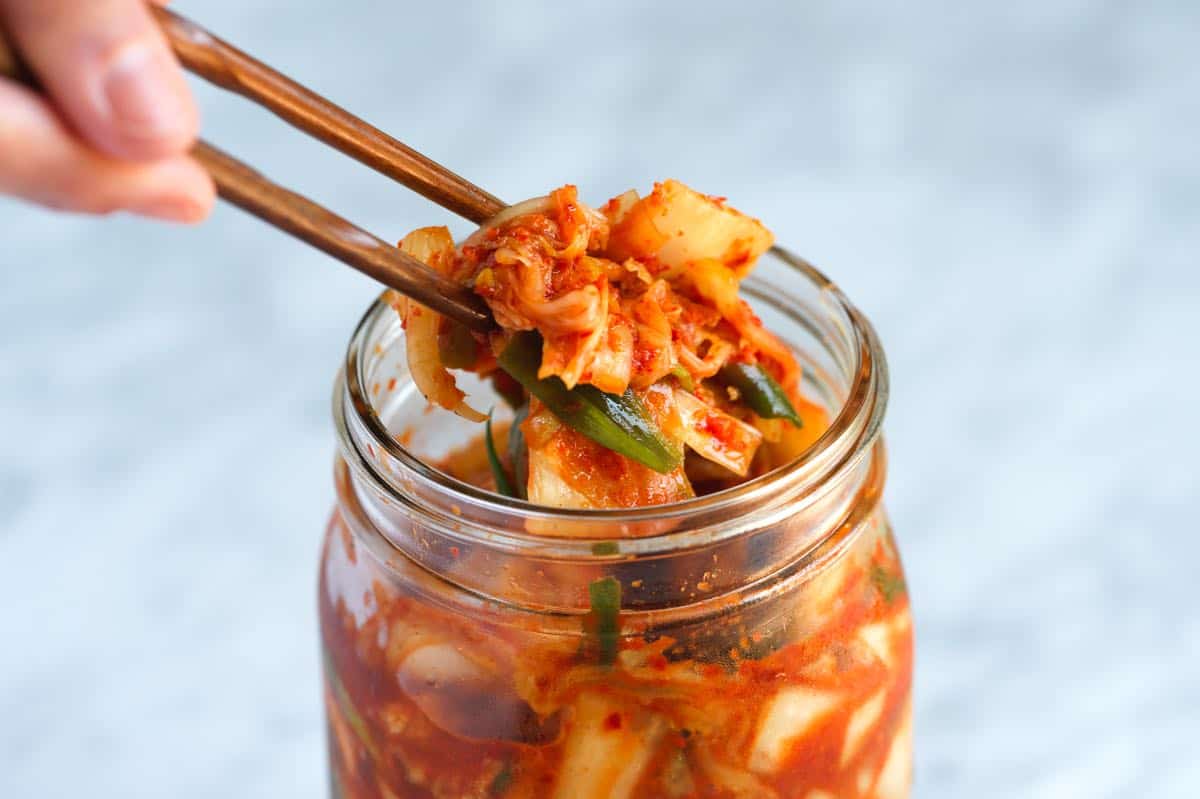
What is kimchi?
Kimchi, also spelled kimchee, is a popular Korean dish made from fermented vegetables. The most common type of kimchi is made from Chinese cabbage (baechu). It is traditionally served as a banchan (side dish with a meal). Kimchi is also used in kimchi fried rice, stews, dumplings, savory pancakes, and noodles. I also add it to sandwiches, wraps and salad bowls and currently my favorite way to enjoy kimchi is with scrambled eggs!
How to make kimchi at home
We still have a lot to learn about making different types of kimchi and love to try and explore other possibilities. Our kimchi recipe below is a good place to start. Depending on how much gochugaru (red chilli powder) you use, you can also adjust the spiciness to your preferred level of spiciness. We developed this recipe with Chef Richard Hattaway. Try it soon. You will love it!
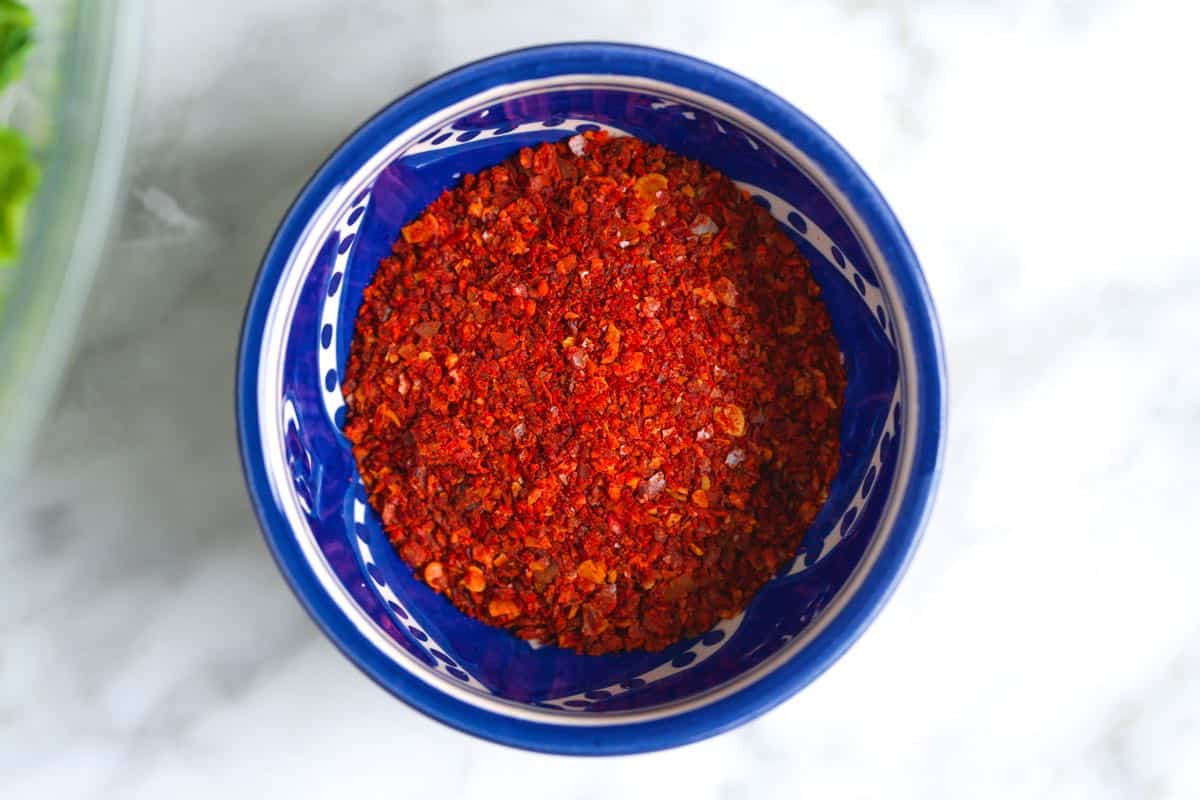
The best thing about kimchi is that it tastes delicious fresh (unfermented) or fermented. So you can prepare a portion, enjoy some as a salad and leave the rest in a jar in your fridge to ferment.
Opinions differ on what makes the best kimchi, and that’s fine. Kimchi is a traditional dish that has been adapted from family to family for centuries. This recipe is our starting point. It requires ingredients we typically have in our region and makes the kind of kimchi we crave.
When preparing kimchi, we must keep the following in mind two basic steps:
- Cut and salt the cabbage. This kills any harmful bacteria and helps draw excess water out of the cabbage. After soaking the cabbage with salt, we rinse and drain until mostly dry.
- Massage in a paste of red chilli powder Add (gochugaru) and other ingredients like garlic, ginger, fish sauce and sugar to the cabbage. You can enjoy the kimchi fresh (immediately) or let it ferment. Fermentation takes place at room temperature or in the refrigerator. It’s slower to refrigerate, but refrigerated fermentation is our preferred method (it’s straightforward and easy).
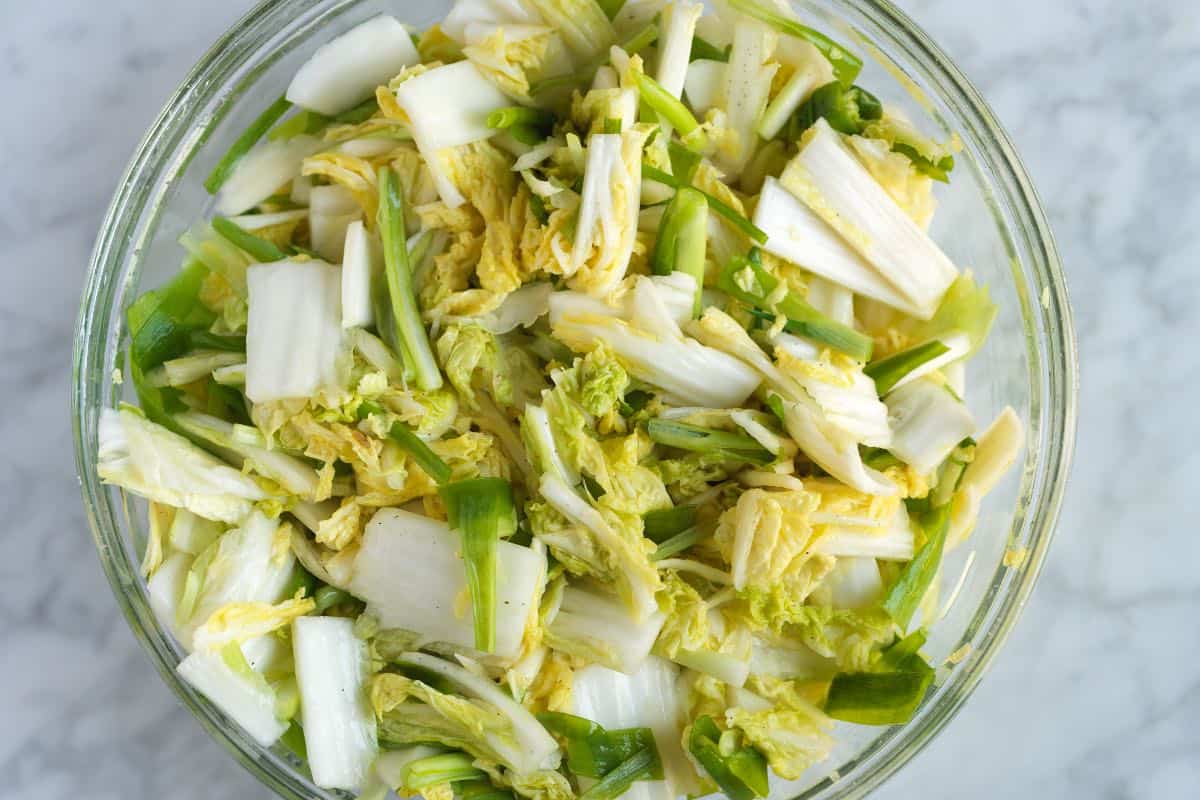
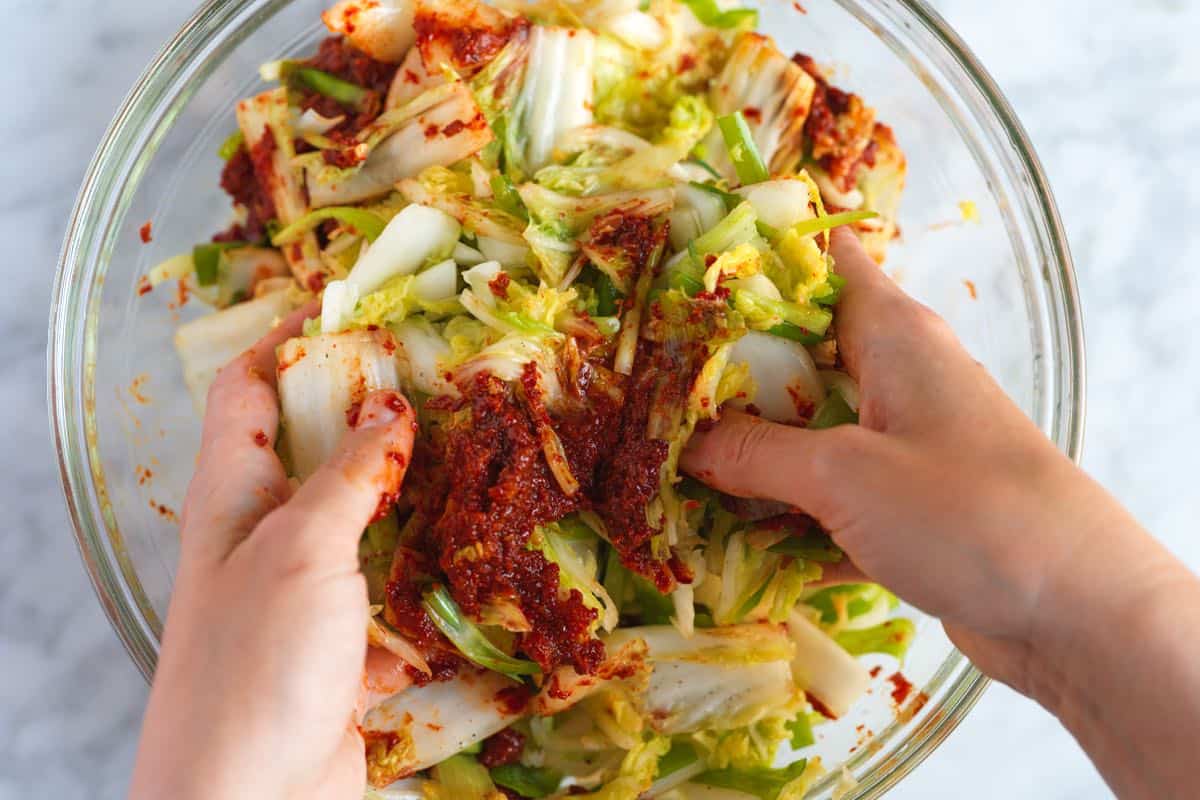
More cabbage recipes: Try our easy fried cabbage or this quick homemade sauerkraut
How long does it take to ferment kimchi?
The fermentation time for kimchi can vary based on personal preference and desired flavoring. In general, fermentation lasts 2 to 3 weeks in the refrigerator.
Some people let the kimchi ferment at room temperature for a day or more. This speeds up fermentation, but we prefer to just pop our jar in the fridge and let it ferment there. It’s a little slower, but after a few weeks, refrigerated kimchi still has the same sour, tingly notes.
How long does kimchi keep?
Kimchi usually stays fresh for several months in the refrigerator. However, its flavor and texture will continue to change over time. Some people prefer the taste of well-ripened kimchi, while others enjoy it when it’s relatively fresh. Personally, I prefer fresher kimchi styles. Please note that our recipe is not designed for shelf life (do not preserve or store unrefrigerated for a long period of time).
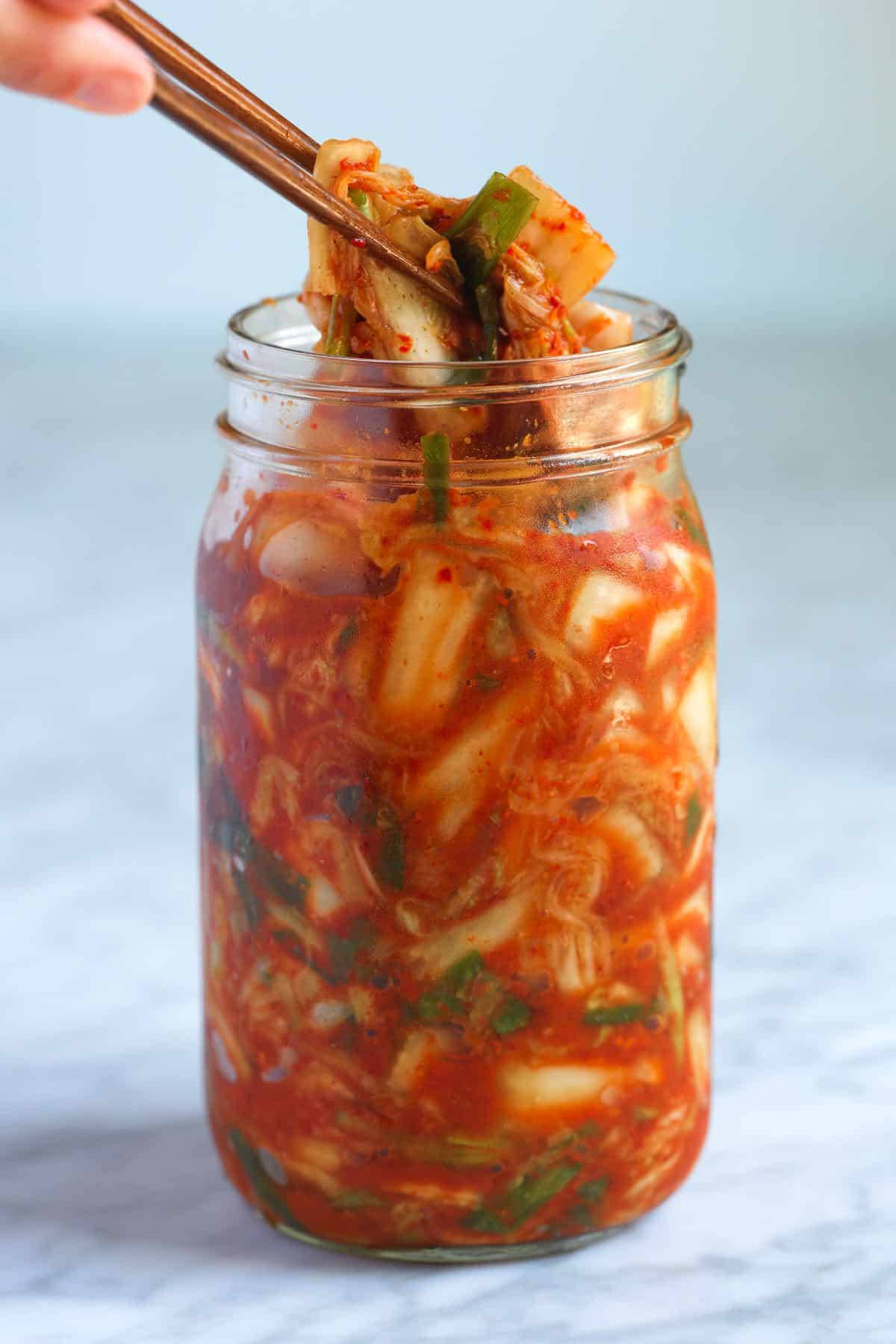
More frequently asked questions
Do I have to use the rice thickener? The optional rice thickener, a mush of rice flour and water, helps our chilli paste stick to the cabbage. To prepare it, simply cook sweet rice flour with water on the stovetop, similar to how oatmeal is prepared. We recommend purchasing sweet rice flour (we use Bob’s Red Mill), but finely ground glutinous rice (often called sweet rice) or jasmine rice can also be suitable substitutes (use a clean electric spice grinder or small blender).
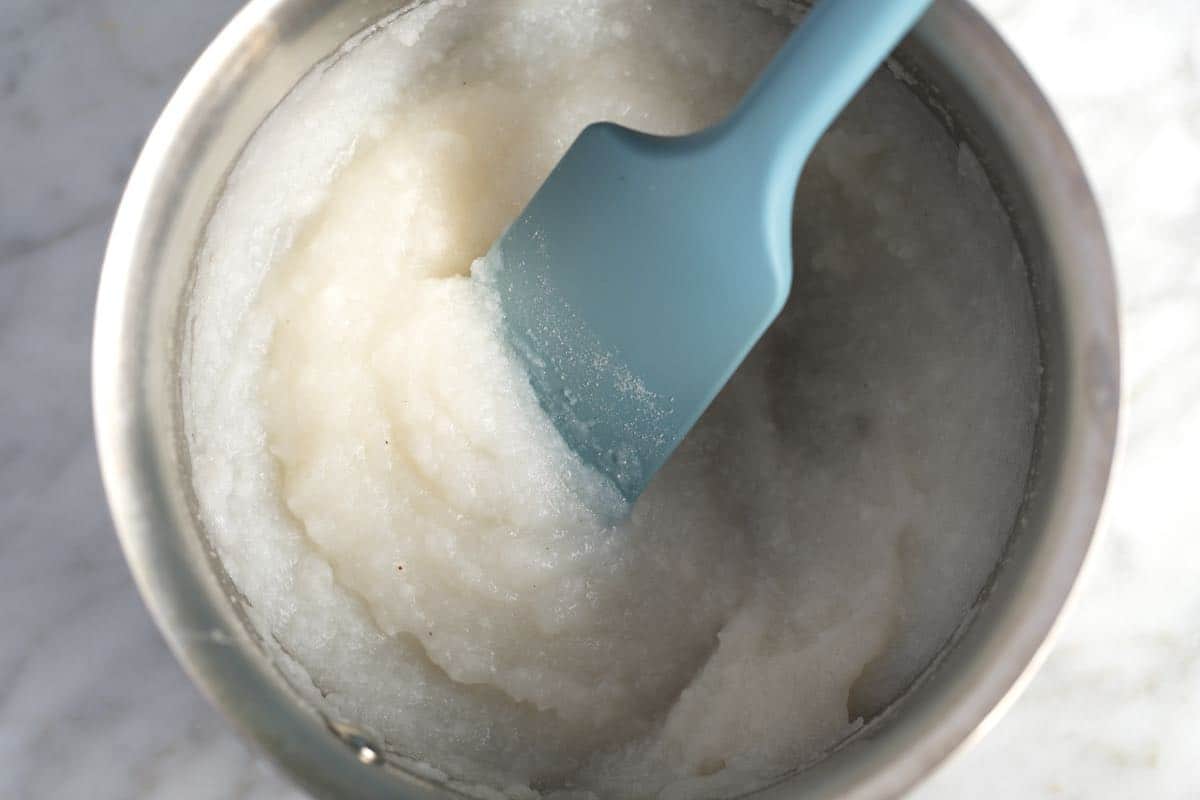
What is the fish sauce for? Kimchi often includes a seafood component such as fish sauce, oysters, squid, or salted shrimp paste. It’s added for umami, a rich, savory flavor. We have Red Boat fish sauce in our kitchen so we use it, but if you have access to a Korean market you can buy Korean fish sauce.
Can I make vegetarian kimchi? Yes! It’s pretty easy to adapt our kimchi recipe below to be vegetarian and vegan. In our recipe, we add fish sauce to give the dish an umami flavor. You can omit this for vegetarian kimchi, or to retain some of that umami flavor, use miso paste (see the Tips section of the recipe below for recommended amounts).
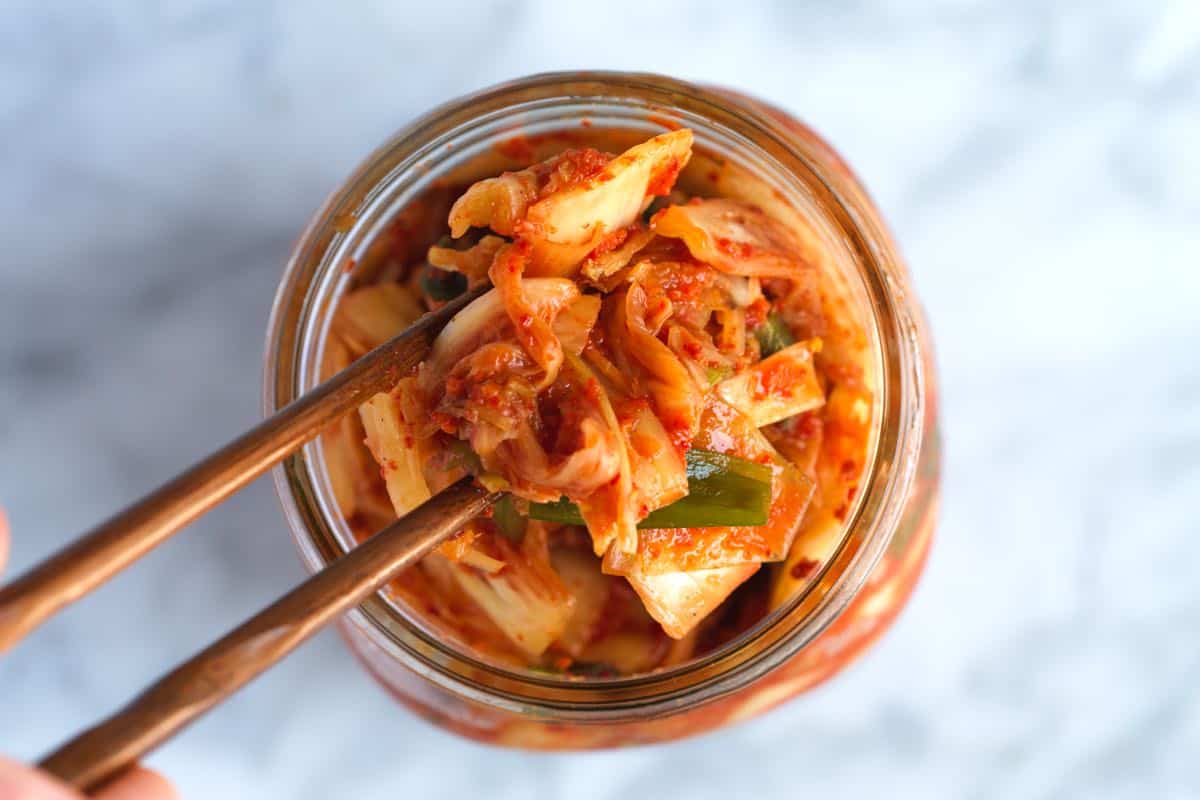
Homemade Cabbage Kimchi
-
PREPARATION
-
IN TOTAL
Our kimchi recipe is suitable for beginners. It’s straightforward and can be adjusted to your desired level of spiciness depending on the amount of gochugaru (red chilli powder) used. While some recipes leave the cabbage in wedges, we cut ours into bite-sized pieces. This simplifies the work and saves some time with the brine. We usually make kimchi with cabbage only and don’t add any other vegetables (except garlic, ginger and green onion), but feel free to add grated Korean radish, daikon or carrot.
Makes 1 1/2 liters
you will need
Kimchi ingredients
1 Chinese cabbage, about 3 pounds
2 ½ tablespoons (42 grams) fine sea salt
12 spring onions
2 tablespoons rice thickener, recipe below
5 tablespoons (45 grams) gochugaru, Korean Red Chili Powder
8 garlic cloves, finely grated
A 2-inch knob of fresh ginger, finely grated
2 tablespoons fish sauce
4 teaspoons of sugar
2 tablespoons of water
rice thickener
1 tablespoon sweet rice flour
1/2 cup cold water
directions
1Prepare the cabbage. Halve the cabbage lengthwise and remove the core. Cut the halves into small wedges, then slice the cabbage crosswise into 3.5 cm pieces.
2Prepare spring onions. Cut off the root ends, discard them and cut the spring onions in half lengthwise. Cut the onion halves crosswise into 5 cm pieces.
3Place the cabbage and scallions in a large bowl (use two bowls if needed). Sprinkle with salt and mix well. Cover with a clean tea towel and let sit at room temperature for 1 to 2 hours, until cabbage is noticeably wilted. After 30 minutes, turn the cabbage to redistribute the salt.
4Meanwhile, make the rice thickener. Combine 1 tablespoon rice flour and 1/2 cup water in a small saucepan. Heat over medium-high heat and cook, stirring constantly, until the mixture forms a thick paste. Take it from the stove and let it cool off.
5Make the chili paste. Combine the gochugaru, garlic, ginger, fish sauce, sugar, and water in a medium bowl. Add 2 tablespoons of the cooled rice thickener. Stir until everything is well mixed. Store in the fridge until the cabbage is done.
6If the cabbage has collapsed, rinse well under cold water (I rinse 2-3 times). Then set the cabbage aside to drain for 20 to 30 minutes (or use a salad spinner to remove most of the water).
7Massage the chili and spice paste into the drained cabbage. Consider using gloves for this step. Continue massing the paste into the cabbage until the entire cabbage is completely coated.
8thPack the kimchi into a 1-liter jar (if you have more, use a second jar or a smaller 16-ounce jar). Gently press the kimchi down until the liquid (brine) covers the cabbage. When your jar is full, leave at least an inch of space between the kimchi and the lid. If you have one, place a fermentation weight on top and seal the jar.
9Place the kimchi in the refrigerator to ferment. After a day, check the kimchi and “burp” it by pressing down on the tightly packed cabbage with a clean spoon to push out any trapped air bubbles.
10You can enjoy kimchi anytime, but after a week or two it takes on weird, sour notes. During fermentation, bubbles may form and brine may ooze out of the glass. Therefore, place the jar in a small bowl to catch it all.
Adam and Joanne’s tips
- Vegetarian or Vegan Kimchi: Omit the fish sauce and add 1 to 2 tablespoons of white or red miso paste to the chili powder mixture before massaging into the cabbage.
- Salt: Use iodized salt. Iodine can prevent proper fermentation.
- Gochugaru: Korean red chili powder or flakes add heat, flavor, and a bright red color to kimchi. We used mother-in-law’s gochugaru in our photos as it’s commonly available at local grocery stores. You can also find gochugaru in international/Korean markets. If you have a choice between spicy and mild, choose mild as you can add more and liven up your kimchi without making it too spicy (tip from Maangchi).
- Spicy Kimchi: Increase the amount of gochugaru in the recipe or use gochugaru labeled “medium” or “spicy” to prepare your batch. You can taste the chili paste while it’s cooking to see if it’s spicy.
- Nutritional Information: The nutritional information below is an estimate. We used the USDA database to calculate approximate values. Note that sodium is difficult to determine using this recipe.
If you make this recipe, take a picture and tag it with the hashtag #inspiredtaste – we love to see your creations on Instagram and Facebook! Find us: @inspiredtaste
Nutritional value per serving
serving size
1/2 cup
/
calories
22
/
total fat
0.5g
/
Saturated Fatty Acids
0.1g
/
cholesterol
0mg
/
sodium
283.7 mg
/
carbohydrate
4.4g
/
fiber
1.3g
/
total sugar
2g
/
protein
0.9g
